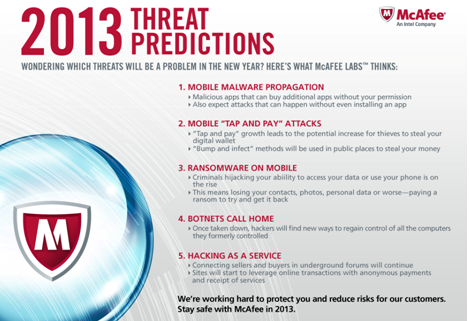What Can We Expect in 2013?
The cybercrime landscape is always growing and changing as hackers look for new ways to make money from us. And 2012 was no different as McAfee Labs™ found huge growth in malicious software and activities.
As the year closes, McAfee Labs looks ahead to see what is on the horizon for 2013. Here’s the areas they predict that we’ll see growth in and that consumers should be aware of.
Malicious app proliferation
As mobile malware grows, we expect to see malicious apps that can buy additional apps from an app store without your permission. Buying apps developed by malware authors puts money in their pockets. We also expect to see attacks that can happen without you having to install an app, so no interaction on your part is needed to spread the malicious app.
Mobile “tap and pay”
Phones with near-field communications (NFC) enabled are becoming more common. As users are able to make “tap and pay” purchases in more locations, they’ll carry their digital wallets everywhere. That flexibility will, unfortunately, also be a boon to thieves Thieves will also use the “bump and infect” method to steal money from your digital wallets in large, crowded areas like airports, malls and theme parks.
Mobile ransomware
Ransomware is quickly moving from the PC to mobile devices. Criminals hijack your ability to access data on your phone or use of your phone, so you are faced with losing your contacts, calls, photos, etc. or paying a ransom; and even when you pay the ransom you don’t always get your data back.
Regaining control of botnets
Botnets are networks of infected computers, that are controlled by a criminal for malicious activities and they are one of the largest sources of spam emails. As cooperation to shut down these botnets grows, the criminals that control these botnets lose money. We anticipate that hackers will find ways to regain control of their botnets (a larger group of computers they have control over) once they are taken down.
Hacking services traded online
Online criminal forums have always been used by cybercriminals to buy and sell malicious services, but they still did most of their actual dealings face to face. In 2013, the growth of traditional e-commerce methods are being used, and anonymity on these sites has improved. Buyers can make their choices with the click of a mouse, use an anonymous online payment method, and receive their purchases without any negotiations or direct contact with the seller.
Here’s some 2013 security resolutions:
Install security software on your mobile device—With the growing amount of mobile threats that we’re seeing, you want to make sure that your smartphone is protected, just like your computer. Consider installing security software such as McAfee Mobile Security, which can guard against viruses and malware, as well as protect your device and information in the case of loss or theft.
Strengthen your passwords—If you’re still using easy to remember passwords that include your home address and pet’s name, it’s time to get serious about creating strong passwords that are at least eight characters long, and a combination of numbers, letters and symbols. Don’t include any personal information that can be guessed by hackers.
Make sure that all of your software is up-to-date— Software updates often include fixes to security holes and other vulnerabilities so you want to make sure that you have the latest version of all your software programs, especially security software. Also, make sure to download application updates when prompted.
Check your bank statements and mobile charges regularly—This way, you can discover and report any suspicious charges.
Finally, as cybercriminals continue developing new attacks, realize that you need to stay up-to-date on the latest threats and how to protect yourself.
Robert Siciliano is an Online Security Expert to McAfee. He is the author of 99 Things You Wish You Knew Before Your Mobile was Hacked! (Disclosures)



























